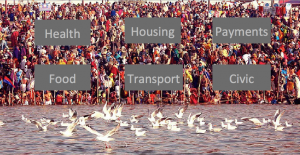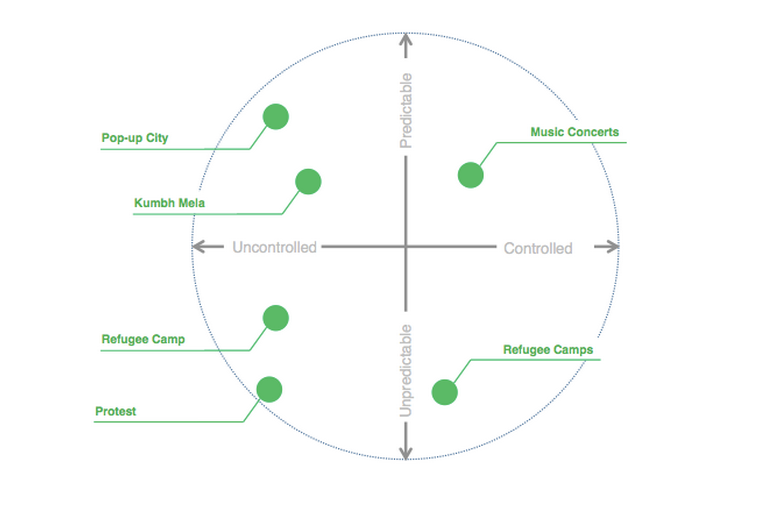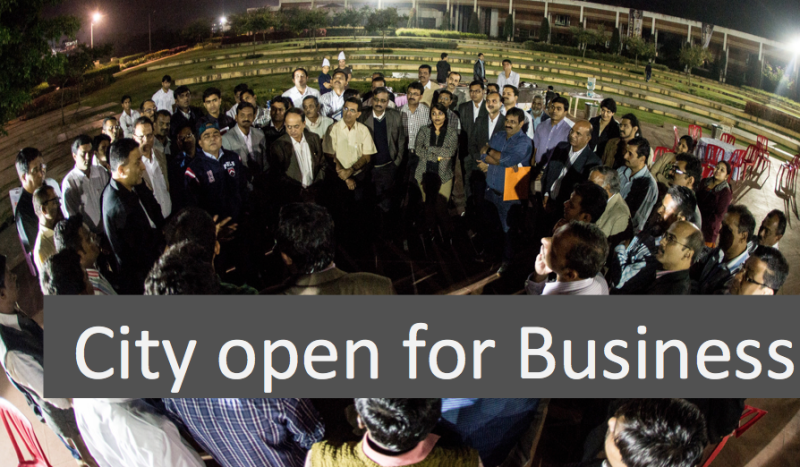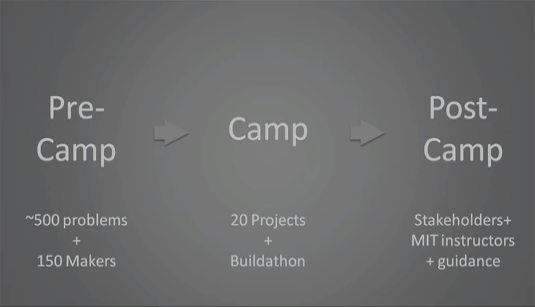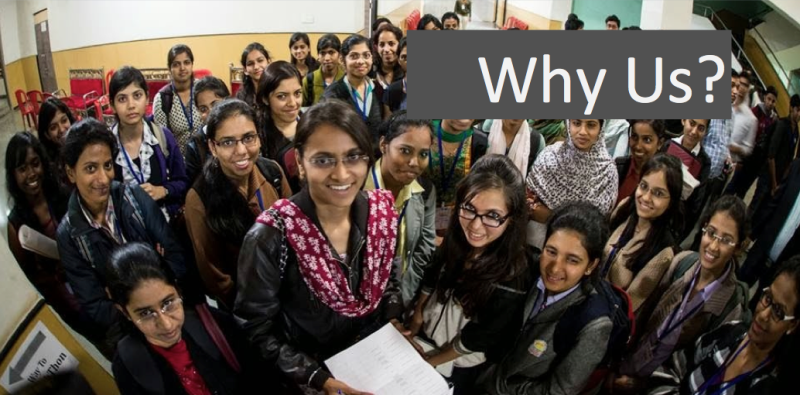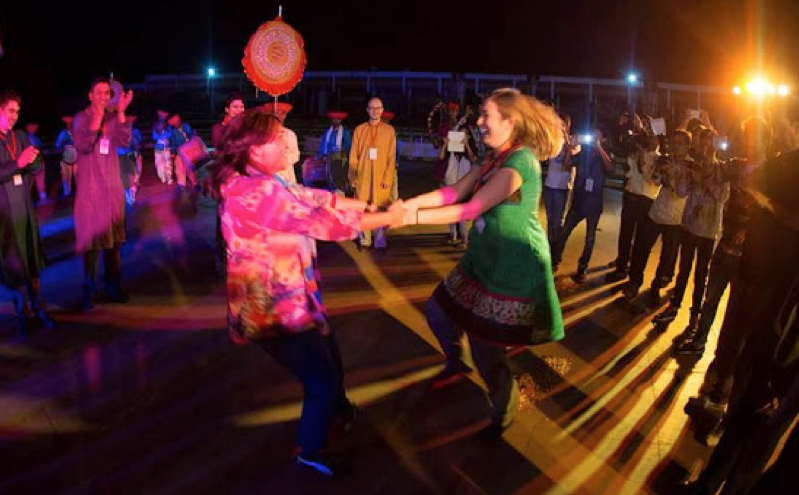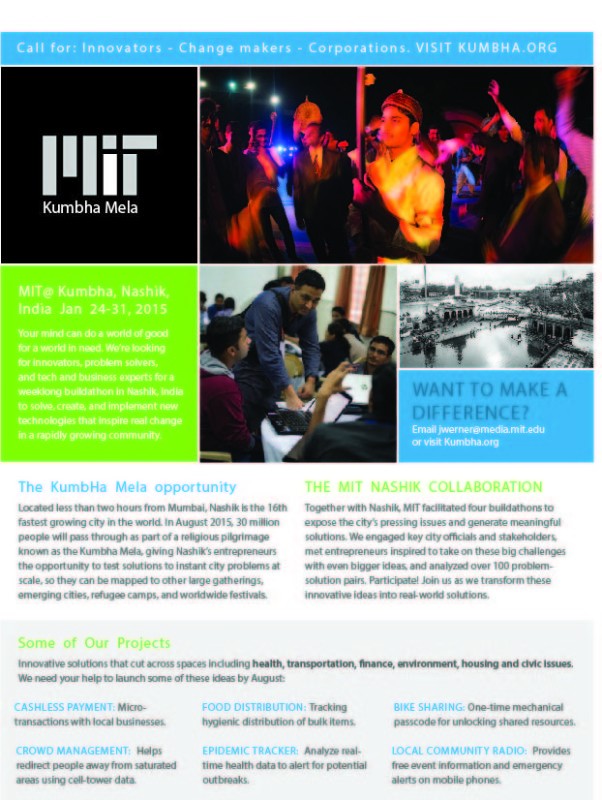The Kumbh Mela Opportunity: Kumbhathon and the Innovation Sandbox
Kumbhathon is a year-round initiative to identify and address the challenges of cities in developing countries. It is not just a hackathon or a competition. It is rooted in a dynamic innovation sandbox in Nashik. Located 2 hours from Mumbai, Nashik is the 16th fastest growing city in the world. In August 2015, 30 million people will pass through as part of a pilgrimage known as the Kumbh Mela. The Kumbh is one of the largest human gatherings in the world. This gives innovators, change makers, entrepreneurs and corporations, the opportunity to learn, develop and test solutions to “pop-up city” problems at scale, instantly, so they can be mapped to large gatherings and emerging cities worldwide. (See Kumhathon presentation at INK Talks). During January 24-30, 2015, the next Kumbhathon Camp will bring together key stakeholders and innovators. Everyone is welcome to participate online or at the venue.
What are the Challenges?
With the excitement and scale of the festival many problems arise. Issues can be found with health, housing, payments, food, water, transport and with civic issues just to name a few. Harvard University performed a fantastic quantitative survey of the Kumbh Mela. The question is, can we now actually influence the Kumbh? And, why us? We find that the government is already focused on the infrastructure of the event. The Kumbhathon initiative encourages solutions that are innovation based, require minimal capital and can scale easily as the number of users grow. Also, these innovative solutions do not depend on policy changes and can be deployed quickly to have great impact. Following the five-stage model below we can bring together innovators to tackle the most pressing issues and push them through to prototype and deployment. This is innovation at scale, using local talent for identifying the problems, engaging stakeholders for rapid feedback, using international talent to brainstorm the solutions and then inspiring thousands of innovators to execute within the innovation sandbox.
The “Pop-up City”
The pop-up cities can appear in so many ways: festivals, concerts, refugee camps . There is a defined scale marking the predictability and control for such events. Addressing Kumbh Mela in this space is critical to showing that we can have impact in an uncontrolled situation and it will allow us to enter other sectors – strengthening the impact with each innovation. This initiative is closely related to others worldwide dealing with smart cities, big data, digital governance and so on. While innovations in smart city initiatives build on top of existing high quality and data-rich infrastructure, innovations for pop-up cities cannot rely on such pre-existing resources. We find inspiration in Deshpande Foundation’s Hubli Innovation Sandbox. Our role is to reimagine Kumbh Mela by simultaneously engaging stakeholders, innovators and organizations.
The MIT Nashik Partnership
Together with Nashik, MIT facilitated four buildathons to expose the city’s pressing issues and generate meaningful solutions. We engaged key city officials and stakeholders, met entrepreneurs inspired to take on these big challenges with even bigger ideas, and analyzed over 100 problem-solution pairs. Now we are inviting innovators, change-makers and organizations worldwide to participate in the next phase to transform these innovative ideas into real world solutions. A Kumbh@MIT workshop at Cambridge, MA in May 2014 lead to discussion on potential MIT research that can play a role in pop-up cities.
Kumbhathon January 2014
The spark for Kumbh Innovation was a casual conversation between Prof. Ramesh Raskar of MIT Media Lab and INK fellow Sunil Khandabahale at INKtalks. To develop these ideas the MIT and Nasik teams have started a workshop model which allows for rapid innovation. First workshop was January 2014. Before the workshop, through offline and online engagements, we encouraged city officials, businesses and citizens to articulate about 500 challenges. We asked innovators in the field to submit problem statements for potential innovation. After selecting top 20 challenges, we issued a nationwide call to solve the problems, From hundreds of applicants, we selected 150 innovators and makers. We gathered at a camp where we hosted a weeklong intensive buildathon. With an experts from MIT, Harvard, Boston area entrepreneurs and many Indian organizations, and deep interaction with city businesses, many of the 20 challenges were studies and solutions explored and flushed out into working prototypes. Teams developed and tested solutions over the next several months via a series of mini-Kumbhathons coordinated by MIT and Nasik teams.
Kumbhathon January 2015
The next big Kumbh buildathon is taking place in Nashik from January 24 to 31, 2015. This workshop will bring together experts to think about issues that really matter and to impact real change. Our goal is provide services for millions by creating a new generation of entrepreneurs dedicated to solve societal problems. The strategy is three-fold: (a) Re-use: new ‘Share Economy’ where every existing resource in town can be dynamically reused, (b) Create: identify/attract new goods+services for millions of visitors and connect them to business opportunities, (c) Quantify-city: provide a backbone of data and live streams that will power the Share Economy and new emerging products.
We encourage solutions that are technology based, require minimal capital and can scale easily as the number of users grow. We discourage solutions that require systemic changes (changing the infrastructure), lot of manpower (service heavy) or require heavy capital (best left to large companies).
Sample Projects Include:
Food Distribution: tracking hygienic distribution of bulk items
Cashless payment: micro transactions with local businesses
Crown Management: helps redirect people away from saturated areas using cell phone tower data for human density
Epidemic Tracker: analyze real time health data to alert for potential outbreaks
Bike-sharing: one time mechanical passcode for unlocking shared resources
Local Community Radio: provides free event information and emergency alerts
Shops Online: tools to bring most informal businesses online to enable data mining
WikiNasik: comprehensive crowdsourced data about the city
LiveNasik: dynamic data streams of transport, health, civic, housing resources
OilExtractor: thousands of liters of oil from temple donations before it pollutes rivers
GoFoodGo: optimized supply chain for donated and homemade food
3DMap: maps customized for events, dates, languages and promotions for an evolving city
We expect these for-profit or non-profit ventures will be managed by new age entrepreneurs. Nasik city is truly open for business: city officials and organizations, via Kumbha Foundation, have made all the arrangements for unprecedented access to the city data and services. See http://tinyurl.com/kumbh2june for ongoing projects and ventures.
How can you be involved?
We are proud to announce that we have started a Kumbh Foundation to support this critical innovation. We look forward to celebrating with you on January 24th-31st in Nashik to look at our accomplishments to date and discuss our future plans. Your mind can do a world of good for a world in need. We have a fantastic group of innovators, problem solvers, and tech and business experts joining before, during and after a weeklong buildathon in Nashik, India. We will have many organization, startups and Forture 500 companies interested in understanding and exploring opportunities for pop-up cities. We hope you will join us to solve, create, and implement new technologies that inspire real change in a rapidly growing economy.
Want to make a difference? Email John Werner: jwerner@media.mit.edu
Main website (Kumbh Foundation and January 2015 camp): http://kumbha.org
Facebook updates: https://facebook.com/
Ramesh Raskar, Sunil Khandabahale and Kumbh Team Present the Initiative at INK: http://inktalks.com/discover/
Kumbh@MIT Brainstom May 2014: http://tinyurl.com/mitmay2014
Read about this “Tech Route” on wn.com
To Get Involved: Email John Werner
Head of Innovation and New Ventures
The Camera Culture Group
MIT Media Lab
jwerner@media.mit.edu


